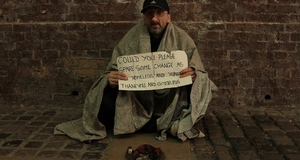Featured Article:Minorities and Homelessness in the United States and Europe: A Comparative AnalysisII. MethodologyI selected the following countries for the comparative analysis: United States, Finland, France, Sweden, Italy, and the United Kingdom. In the United States, homelessness data is collected at the national level through the annual Point in Time Surveys, conducted by local communities and submitted to the Department of Housing and Urban Development (National Alliance to End Homelessness, 2012). Estimates of the number of people experiencing homelessness in the United States range from 1.6-3.5 million people (National Coalition for the Homeless, 2009). The variance in numbers stems from the elusiveness of the problem and the difficulties in counting the homeless. The Point in Time surveys conducted one night each year include people who are able to be reached on the streets, those in emergency shelters, those in transitional housing, and permanent supportive housing (U.S. Department of Housing and Urban Development, 2011). The United States defines a homeless person as one that: Lacks a fixed, regular, and adequate night-time residence; and... has a primary night time residency that is: (A) a supervised publicly or privately operated shelter designed to provide temporary living accommodations... (B) An institution that provides a temporary residence for individuals intended to be institutionalized, or (C) a public or private place not designed for, or ordinarily used as, a regular sleeping accommodation for human beings (National Coalition for the Homeless, 2009). The United States categorizes a person as chronically homeless if he or she is an unaccompanied homeless individual with a disabling condition who has either been continually homeless for a year or more or who has had at least four episodes of homelessness in the past 3 years (U.S. Department of Housing and Urban Development 2011, 3). In Europe, homelessness remains a national and/or local level competence, although there is a growing call for EU action. Scholars have called for an EU Directive which would bind member states to address homelessness (Fernandez, 2008). The European Federation of National Organizations Working With the Homeless (FEANTSA) is at the forefront of European homelessness studies; in 2011, FEANTSA issued a letter calling on the EU Commission to directly address homelessness and housing rights in line with a European Parliament declaration calling for: housing-led approaches, links to structural funds, and a framework for monitoring and reporting on the development of national and regional strategies (Feantsa.org, 2011). There are an estimated 3 million people homeless throughout Europe (Fernandez, 2008). Many of the same hurdles in counting the homeless found in the United States are also common throughout Europe.Although a European definition of homelessness does not exist, FEANTSA and the European Observatory on Homelessness have developed a typology, by synthesizing national reports. Homelessness in Europe is defined as the lack of either a legal, physical, or social domain ie. the lack of a roof, a legal title, or a private and safe personal space for social relations (Edgar 2009, 16). As in the United States, European countries provide outreach services, emergency shelters, and transitional housing. In addition, hostels serve as a refuge, and an attempt is made to count this population. The category of chronic homelessness is also found in the European setting (Edgar, 17-22). In Europe, national data collection strategies on homelessness are shaped and can be identified according to groups of welfare regimes. There are wide disparities in capacity or national will to count the homeless population. Nordic model countries (Denmark, Finland, Norway, and Sweden) conduct yearly national surveys and possess clear national strategies, monitoring, and enforcement responsibilities (Edgar 2009, 23). Liberal Atlantic countries (UK and Ireland) vary between Ireland, which has a national strategy, and the UK, which has regional variations of data collection methods (Edgar 2009, 24). Austria, Belgium, France, Germany, Luxembourg, and Netherlands comprise the Continental model, which makes use of the census and surveys, with variations among countries that do not have national competence regarding homelessness (Germany, Austria) and countries that do (France). In the Mediterranean model countries, Spain addresses homelessness on a federal level, Greece does not have a national strategy, while Italy’s national data collection is minimal (Edgar 2009, 25-27). Finally, the new Eastern European member states have unreliable data on homelessness, and services for the homeless are in the beginning stages (Edgar 2009, 27-37). Tables 1 and 2 below display the composition of minority groups as a share of the homeless populations and as a share of the total population of each country being studied. As can be seen, in all countries, minorities are over-represented. The groups of people constituting minorities vary by country, but in general they are people of color. Note that the lack of overrepresentation of Latinos among the homeless in the United States has been described as the Latino Paradox and has been attributed to strong traditions of family support (Rosenheck et al 1998, 20). Table 1. Composition of minority groups among the homeless as compared to their share of the total population in the United States and selected European countries.
Sources: US Department of Housing and Urban Development, The 2010 Annual Homeless Assessment Report to Congress, June 2011; Finish Ministry of Social Affairs and Health, National Strategy Report on Social Protection and Social Inclusion, 2008; Statistics Finland, ; FEANTSA, Homeless Immigrants in Finland, 2002; French National Institute of Statistics and Economic Studies (INSEE), “Specific Aspects of Poverty: Homeless People,” 2005 ; INSEE, 2004-2005 Annual Census Surveys, ; Swedish National Board of Health and Welfare, “Homelessness in Sweden in 2011,” 2011; Department of State, Background Note: Sweden, < http://www.state.gov/r/pa/ei/bgn/2880.htm>; Tosi, Antonio, “Demographics and Trends of the Homeless Population in Italy: Point-in-Time Studies,” , 2004; Italian National Institute for Statistics (ISTAT), Foreign Resident Population 2002 and 2008, ; Braga, Michela, and Lucia Corno, “Being Homeless: Evidence from Italy,” Working Paper n.2009-17, September 2009. Table 2. Composition of minority groups among the homeless as compared to their share of the total population: United Kingdom.[1]
Sources: The Department for Communities and Local Government, “Statutory Homelessness: Households Accepted by Local Authorities as Owed a Main Homelessness Duty by Ethnicity, England, 1998-2011,” ; CRISIS, “The Hidden Truth About Homelessness: Experiences of Single Homelessness in England, May 2011 . Office for National Statistics, Neighborhood Statistics, England, Resident Population Estimates by Ethnic Group. The hypotheses I developed and tested reflect the different theories described in detail in the literature review as to the causes of homelessness: individual-level explanations that place a strong causal role on factors such as mental illness, drug and alcohol addictions, domestic violence, medical conditions, and lack of education or job skills; structural level factors which emphasize poverty, the erosion of the nuclear family, rising individualism, and lack of affordable housing driven by neoliberal policies; immigration laws that marginalize migrants by excluding them from equal rights and resources; the relational sociological approach which looks at categorical inequality and the legacy of slavery and colonialism which created persistent unequal categories based on gender, race, and immigration status and which explains minority homelessness on the basis of social exclusion, and indirect or direct discrimination; the human rights framework which interprets the categorical inequality framework slightly different by drawing attention to the link between lack of civil and political rights such as discrimination or disenfranchisement and lack of economic and social rights such as housing. Due to the fact that this study does not include interviews with people that are homeless in Europe, in the comparative context, I hypothesized the following:
I tested hypotheses 1a and 1b by analyzing eligibility requirements for immigrants to receive welfare and homeless assistance in the United States and the European countries under study. Furthermore, I researched examples of housing discrimination in Europe. I also attended a Migration Policy Institute panel composed of integration ministers from various European countries addressing immigrant integration in Europe, where I was able to directly ask questions. Finally, I contacted a total of 13 European NGOs and government agencies working on homelessness in the countries under study:
All representatives of organizations were asked the following questions:
In the United States, the study was largely ethnographic. The ethnographic method is rooted in anthropology and sociology and is based on fieldwork, mainly participant observation. Ethnographic studies can range from complete immersion of the researcher into the studied community, to strict separation between participant and observer (Genzuk, 2003). Ethnographic research taps both top-down views, such as those of policy makers, and bottom-up views, such as those of the people being serviced (Genzuk, 2003), in this case, people that are homeless. Therefore, I conducted interviews2 with a total of 44 men and women in Washington, DC, Alexandria, and Arlington homeless shelters, taking place between May and July 2012. I solely interviewed single individuals, because this study does not address family homelessness, which would require special attention and is a topic of further research. All of the shelters in D.C. that I gained access to were operated by Catholic Charities. I have conducted interviews at the following shelters: 801 East Men’s Shelter (Washington, DC); Adam’s Place Men’s Shelter (Washington, DC); New York Avenue Men’s Shelter (Washington, DC); Nativity Women’s Shelter (Washington, DC); Harriet Tubman Women’s Shelter (Washington, DC); Sacred Heart Day Program (Washington, DC); Christ House Transitional Program (Alexandria, VA); Volunteers of America Residential Program Center (Arlington, VA). The interviews were guided by discussions of life experiences, to better trace and understand the processes that led to people’s homelessness. Durable inequality can be detected by comparing the relational constraints different groups have. I looked for indicators discussed by Marcuse, Rosenheck et al. Tilly, Pager, and Pettit and Western, and I interviewed both whites and minorities to see if the processes that led to white homelessness are similar or different that those of blacks. More specifically, these were the hypotheses tested for the U.S. part of the study: 2. All people that are homeless possess vulnerabilities interfering with their ability to gain stable living such as: mental illness, drug and alcohol addictions, physical disabilities, and domestic violence histories most notably in women (individual level
The following topics were discussed in the interviews: age, education level, citizenship status; mental health; childhood and home ownership of parents; life and events immediately prior to experiencing homelessness; access to health insurance and government benefits before and after experiencing homelessness; interactions with public officials, employers, and service providers before and after experiencing homelessness; employment and wage history; interactions with the criminal justice system; drug and/or alcohol addiction issues. The professionals interviewed in the United States consisted of one professor in the School of Social Work at Howard University, three social workers specializing in homeless populations, and one homeless shelter program director. The professionals were asked questions along the lines of those asked of European professionals:Continued on Next Page »
Suggested Reading from Inquiries Journal
Inquiries Journal provides undergraduate and graduate students around the world a platform for the wide dissemination of academic work over a range of core disciplines. Representing the work of students from hundreds of institutions around the globe, Inquiries Journal's large database of academic articles is completely free. Learn more | Blog | Submit Latest in Sociology |


















